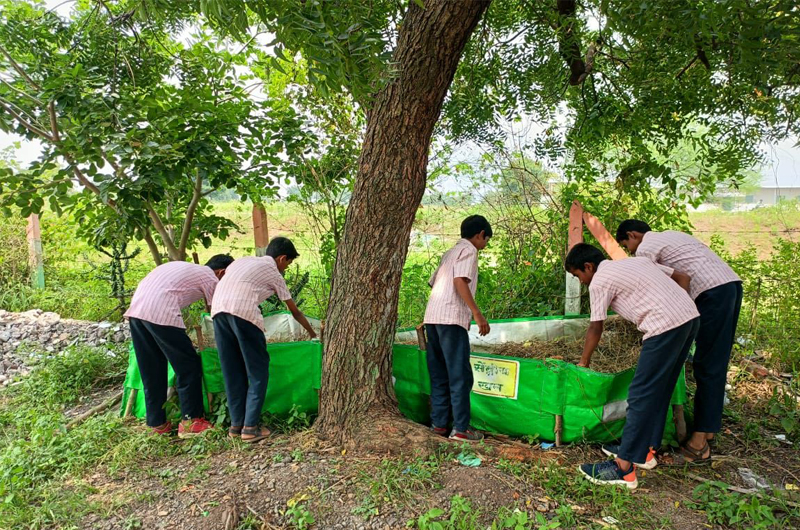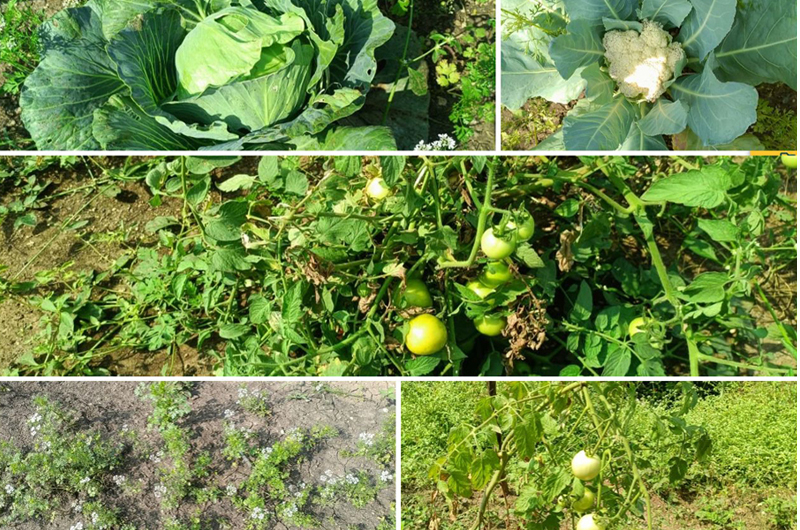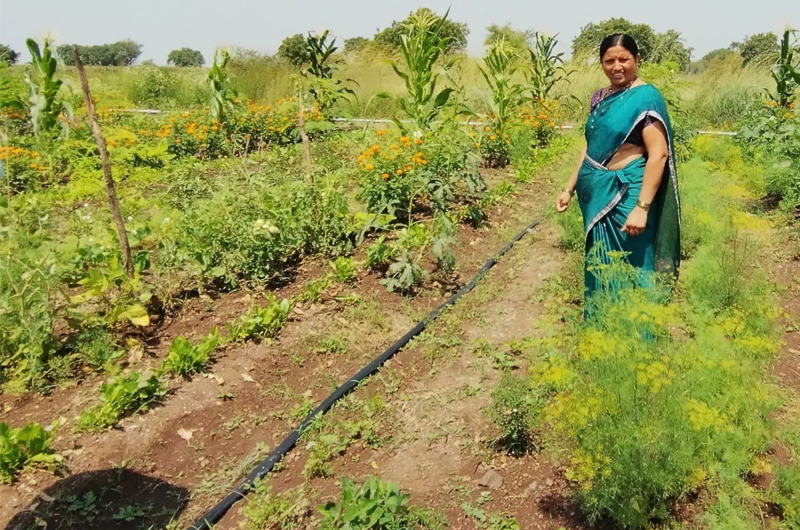This article by Nikhil Nikam, Dada Dadas, Faraz Rupani, Vandana Patekar and Pravin Jogdande is from a blog post which is based on a unique multilayer farming initiative implemented as part of the Integrated Water Resources Development and Promotion of Ecosystem-based Adaptation in Maharashtra and Telangana—A Practice and Knowledge Embedded Approach Project, supported by the Honeywell Hometown Solutions India Foundation. In the Jalna District of Maharashtra, the farming initiative was launched to engage school-going students in Goshegaon Village. The initiative aims to demonstrate its potential to address food and nutritional security while promoting sustainability and resilience within the community
The COVID-19 pandemic reinforced the critical importance of food and nutritional security, especially among vulnerable populations. In semi-arid regions, agriculture-dependent communities face multifaceted challenges due to climate change, which includes not only physical and ecological risks but also socio-economic vulnerabilities.
In the Jalna District of Maharashtra, climatic stresses such as droughts and erratic rainfall have severely impacted agricultural production. The 2023-24 drought was followed by a wet drought, causing significant disruptions in agricultural production and food security. Farmers were left grappling with difficult decisions: ensuring adequate agricultural production or conserving water for domestic needs. Such climatic stresses increase long-term food insecurity, particularly affecting children under five years, who are most susceptible to malnutrition. Against this backdrop, a multilayer farming initiative was launched to engage school-going students in Goshegaon Village. The initiative aims to demonstrate its potential to address food and nutritional security while promoting sustainability and resilience within the community, contributing to the larger initiative of school kitchen gardening by the state and union government.
Small and marginal farmers in India make up about 85 per cent of the agricultural workforce. Due to mono-cropping and the cultivation of only a few varieties of food crops in semi-arid regions, the farmers are especially vulnerable to food, income, and nutritional security. The multilayer farming initiative by WOTR was designed to build resilience during crises such as droughts or pandemics. By cultivating various types of vegetables, pulses, and fruits in complementary layers, multilayer farming provides diverse food sources while offering numerous indirect benefits:
- Improved soil health: Enhances moisture retention and supports microflora
- Pest control: Some trap crops act as natural pest repellents/ attractors
- Optimal land use: Maximises productivity in limited space
- Diversified Nutrition: Provides households with varied fruits and vegetables for balanced diets
This approach has already been implemented by WOTR across 10 states in India. WOTR’s field and research teams selected Ghoshegaon and Deulgaon Kaman Villages in Jalna District to demonstrate EbA (Ecosystem-based Adaptation)in collaboration with the Krushiyug Farmer Producer Organisation. One of the implemented activities involved multilayer farming among the farmers. Following the successful implementation of the initiative, it was uniquely integrated into the extracurricular activities at Satyashodhak Madhyamik Va Uccha Madhyamic Vidhyalay, a local school. As part of the initiative, agricultural practices were introduced to students to enhance their understanding of food and nutrition security. This effort aligns with state and central government policies, such as the National Education Policy (NEP) 2020. The initiative can serve as a model to familiarise students with the latest knowledge in Agriculture and Allied Sciences. Ultimately, this will help retain and attract young talent to the field of agriculture.

Role of community support
Several challenges arose during the construction of the multilayer farm, the biggest of which was convincing school authorities of the benefits of multilayer farming. It took persistent efforts for the authorities to agree, but then even more challenging was dealing with uneven, rocky, and barren land that had little to no farming potential for years. The team focused on identifying methods to level the land and arrange for fertile soil to transform the uncultivable area into cultivable land. However, due to the monsoon season, the percolation tanks and ponds that could have provided soil were filled with water. The farmers who had initially offered to donate soil could not do so since they had already sown their second crop of the year, leaving soil unavailable for the multilayer farm.
Amidst these challenges, Meenabai Mohite emerged as a key supporter. Having established her own successful multilayer farm in August 2023 with WOTR’s assistance, she had witnessed the benefits, such as improved nutritious food intake of the family due to increased access to fresh produce. Recognising the potential of the school’s initiative, Meenabai generously offered a two-guntha plot and irrigation facility next to the school, enabling them to create their own farm. She also shared her valuable knowledge and experience with the students, guiding them in understanding and implementing multilayer farming effectively.
It was necessary to expose the school students to the concept of a multilayer farm and its management before starting land preparation activities for their own multilayer farm. Meenabai’s farm (100 metres from the school) served as an introduction to the concept. Additionally, the students were introduced to the practice of cultivating vegetables and fruits without chemical fertilisers and pesticides. Based on the knowledge gained from the exposure visit and Meenbai’s sharing of her lived experience, the students and faculty began planning the multilayer farm in accordance with WOTR guidelines, which primarily emphasise systematic placement of 35-40 varieties of plants. Vermicompost preparation, Dashparni Ark formulation, Amrutpani preparation, Jeevamrut preparation, trap crops, and irrigation management are also a part of these guidelines.
Facing the unexpected challenge of drought
The school’s ambitious multilayer farming project faced a significant setback due to severe drought conditions. The El Niño effect in the previous year brought an unprecedented water scarcity to the region, posing a formidable challenge to the initiative. In response to this crisis, Meenabai stepped in with a crucial intervention, providing drip irrigation sets to replace the water-efficient rain pipe method. Thus, despite severe water scarcity, the multilayer farming project yielded substantial benefits, particularly in supplying vegetables for the school’s mid-day meals. This experience proved invaluable in educating students about water conservation and efficient resource management. The students gained practical insights into the critical importance of water and learned firsthand how to maximise its use in agriculture
However, the persistent drought conditions ultimately overwhelmed their efforts. As the water shortage intensified, even basic drinking water became scarce in the village. This extreme situation made it impossible for students to sustain the plants, leading to significant losses. The struggle to keep the plants alive under such harsh conditions provided a stark, real-world lesson on the challenges of agriculture in water-stressed environments. This challenging period, while disappointing, served as a powerful educational experience in climate resilience and resource management. It highlighted the critical need for adaptive agricultural practices in semi-arid regions prone to water scarcity, preparing students for the realities of farming in a changing climate.
Although the drought destroyed everything on the plot, the knowledge and confidence gained from cultivating a multilayer farm on Meenabai’s land remained intact. The students were finally ready to develop a new multilayer plot behind the school, which was a significant step toward expanding sustainable agricultural practices within the village and potentially cultivating future farmers of the community.
The core team proposed desilting the nearby pond to source fertile soil for the multilayer farm, which would also help increase its storage capacity. With the approval of the gram panchayat, the pond was desilted, yielding 60 trolleys of silt (approximately 271.6 tonnes). Land-levelling was completed immediately after the silt was dumped onto the plot. To ensure a smooth transition into the monsoon season, arrangements for seeds and plants were made well in advance with the assistance of a local nursery. These seeds/ saplings were planted at the onset of the rainy season, allowing students to apply their learning and efforts effectively.

meals of the 240 students. Photo: WOTR.
Benefits
The multilayer farm provides vegetables for the mid-day meals of the 240 students (126 boys and 114 girls) who benefit from the project. Ashwini Jaiwal, a Class 10 student, notes: “We worked hard to develop this WOTR-supported multilayer farm at our school. We grow a variety of vegetables, including cabbage, chilis, coriander, and eggplant, all without chemicals. The farm provides vegetables for our mid-day meal program, so we no longer need to buy them from the market. We expect to harvest fruits from the farm next year.”
The multilayer farming initiative has improved the availability of nutritious food, which will help address nutritional issues among school students. The headmaster of the school shared his perspective: “Our students gain valuable agricultural skills by growing fresh, natural vegetables themselves, leading to improved health and nutrition. This also saves money that would have been spent buying vegetables from the market.”
This school multilayer farming initiative was also appreciated by Mukhya Mantri Majhi Shala Sundar Shala (Chief Minister My School Beautiful School Campaign) evaluation team and block education Officers. The multilayer farm’s success highlights the potential of multilayer farming to address food security and nutritional challenges, aligning with SDG-2. Scaling such initiatives could benefit communities across India, particularly in combating anaemia, which affects nearly one-third of adolescents.
(Courtesy: WOTR/ wotr.org)



 from Webdoux
from Webdoux